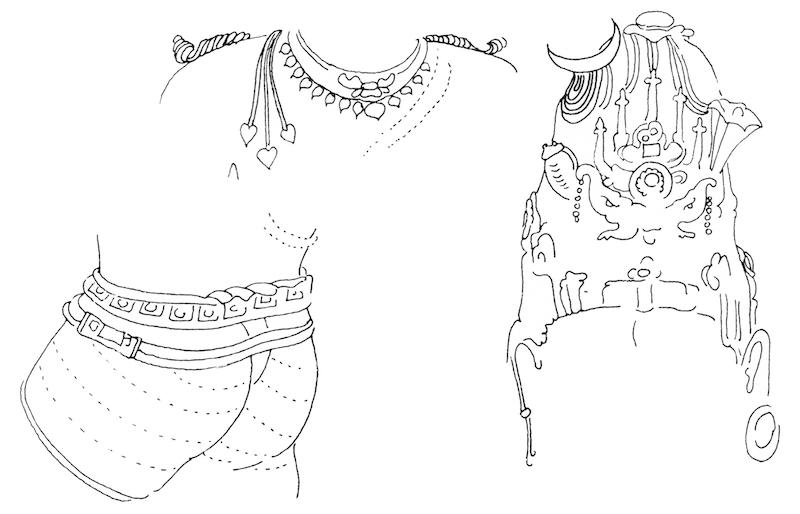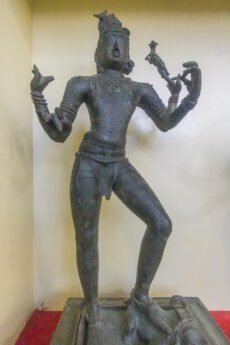Bronze figure from the Thanjavur Art Gallery.
Description
The Siva under description is presented as Dakshinamurti with his arms in a pose to hold the vina (the stringed instrument), the fingers in position to play the instrument.
Except for the position of the fingers and inclusion of an Apasmara (Muyalaka) under the left foot of the image, the iconographic form is the same as that of Tripurantanga described earlier.
Dakshinamurti is in standing pose with the right leg firm and straight. The left foot is slightly bent (in kunchita), the foot being placed over the crouching demon (Muyalaka usually seen under the foot of Nataraja).
The image and the demon below rest on a rectangular base plate which is suitably accommodated over a rectangular bhadrapitham.
The bhadrapitham is a separate piece provided with a seating for the base plate of the image. A set of four rings both at its top and its bottom is seen, the former intendend to secure the base plate of the image to it and the later to secure the image during processions.
Two broken stumps of the tenons may be observed on either side of the lower bhadrapitham at the top. This is for insertion of a prabhavali which was not available in the collection. The broken stumps are placed obliquely, so that prabhavali is in a line with the pose of the image.
The head is crowned with a highly ornate jata-makuta which is of the type found in very early Chola images. The crescent moon and the hissing serpent on the right side and the datura flower on the left are sculptured in bold relief to give a striking and pleasing appearance.
Chudamani and flower designs add grace to the head dress. No design of the skull in the centre had been provided. The usual siraschakra on the back is of a simple type of the early Chola period. There are ten ringlets of hair, of which eight adorn the nape of the neck and two roll down the sholders on either side in the place of the bahulamala of flowers.
The streamer on the right shoulder flowing at right angles from the sholder is a three-forked tassel of necklace strings, displayed prominently. The vertical streamer of hair-locks usually shown on the left is absent.
The face is square-set, and beams with an expression concentration on the music that the God plays on the vina. The nose is natural and the lips well set to bring out the expression. The eyebrows are softly modelled without being dented or line-modelled as in later figures. The central eye is marked on the forehead. The right ear lobe is empty while the left is adorned with a patra-kundala which is compact, narrow and protruding in the front.
Three necklaces, a simple kanti, kasumalai and a plain yajnopavita of three strands without the bifurcating strands are the only decorative ornaments of the flat chest. The absence of udara-bandha adds simplicity and grace to the torso of excellent proportions. The hip lines have been elegantly rendered. The ardhoraka (shorts) is held in position by a metallic belt of floral designs without the simhamukha clasp.
A simple tasselled loin flap hangs down in front between the thighs to cover the genitals. This has been tucked up at the back to form the pleat. The long vertical tassel hanging down in front of the right thigh adds beauty to the slim legs, which are otherwise bare except for one anklet without any ornamentation.
The demon under the left foot of the image is lean and youthful, crouching on all fours in the usual pose, His right hand holds the serpent by the tail, while the left hand in sarpa-mudra (pose like a hooded serpent) fondles over the hood of the hissing serpent. Usually in the Nataraja images, the hissing snake held by the dwarf under the foot of Nataraja images faces the demon but here it faces the worshipper.
Large patrakundalas adorn the ears. In another specimen of the same Vinadhara image, the dwarf demon has been replaced by a pleasing yet grotesque figure of a sivagana intently listening to Siva’s music (Vide Cat. No. 32).
The God has the usual four hands. The upper right holds the axe (broken) while the left holds the antelope. The two lower hands are in position to hold the vina. The middle finger is so set to give the impression of plucking the “sarini” string of the vina, while the corresponding finger of the left hand is placed on the lower note in the madyasthayee on the first string “sarini”.
The position of the thumb, and the first finger of the left hand and the gap between them may be specially noted. They are wide apart in this image, while they are closer to hold the bow-in Tripurantaga images in order to hold the bow (Cat. No’s. 26 to 30). The palm and the thumb sliding over the vina-danda (the shaft of the instrument) is suggested in the pose of the left hand. See the similar rendering in the image described under Cat. No. 32.
The image is a new acquisition to the Art Gallery during the year 1975 from a Kali Temple in Ponvilaindanpatti, a hamlet of Solagampatti, Thanjavur Taluk, which was under the sway of Mutharayars (vassals under the Pallavas, predecessors of the Cholas). An unpublished inscription referring to the Mutharayars is still available on a stone slab near the temple. There is no ancient temple in the village, although villagers state that there once existed a Chola-period temple in the village. Over the intervening centuries it is possible that such a temple may have been destroyed.
Considering the characteristics of this unique piece, which present the style of early Pallava art, and the bhadrapithams of the pre-Chola type (associated with Jain art) provided for it, the image has to be associated with an ancient temple of some importance before the 9th Century A.D. at this place of near this locality. No specific information is available at present.
However, it may be stated here that the villagers who were persuaded to deposit the image in the Art Gallery said that mud and earth were found originally still sticking on to certain parts of the image.
The above information suggests that the image could have been a treasure trove find in some other locality, removed and preserved in the Kali Temple of this village.
The image is an outstanding one. The image has to be rated as one of the best classical figures of the very early Chola period, if not of the still earlier Pallava of Mutharayar epoch.1
Informations
Acc. No.: 225
Century: 7-8th CE
Place of discovery: Sholagampatti (Ponvilaindianpatti)
Taluk: Thanjavur
District: Thanjavur
State: Tamil Nadu
Country: India
Exhibition Location: Thanjavur Art Gallery
Height: 90 cm with pedestal, 76 cm without pedestal
Breadth: no information about the breadth
Weight: 56.3 kg, 42 kg Figure alone
Pictures
Map
- see Rathnasabapathy, S., The Thanjavur Art Gallery – Bronze Sculptures – (A Discriptive Catalogue with Illustrations in Colour) – Volume-I, 2009, pp. 87-91 ↩


Leave a Reply